World Senior Championship 2023 passes midpoint
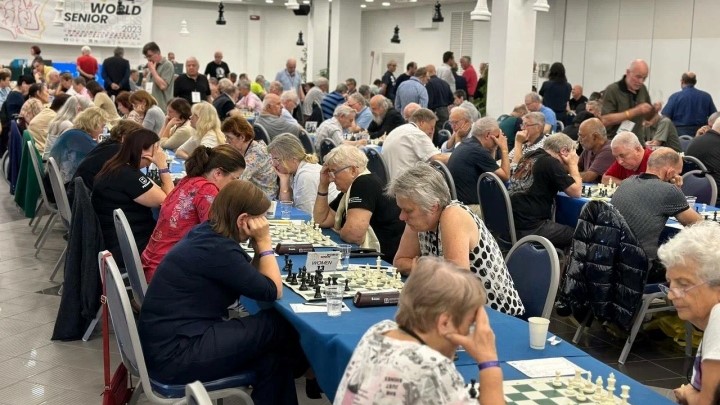
It is the halftime at the World Senior Chess Championship 2023, here at Terrasini, and the participants are enjoying the day off. After visiting the beautiful city of Palermo the players are getting ready to continue battles for the titles in second half of the tournament, starting on November 1. In the meantime, let’s check out the results and standings of the WSCC 2023. After Round 6, in the Open 50+ category GMs Ivan Morovic Fernandez (CHI; pictured below), GM Suat Atalik (SRB), GM Michael Adams (ENG) and GM Artashes Minasian (ARM) are tied for the top position, each scoring 5/6. Six players, GM Maxim Novik (LTU), GM Darcy Lima (BRA), GM Klauss Bischoff (GER), GM Hannes Stefansson (ISL), the defending champion GM Zurab Sturua (GEO) and IM Uffe Vinter-Schou (DEN), are trailing the leaders by just a half-point. In the Open 65+ category, the defending champion GM John Nunn of England (pictured below) is leading the race with 5.5 points after 6 games (the highest score in the event so far). Following him, there are 5 players, sitting on 5 points: GM Nikolay Legky (FRA), FM Ole Christian Moen (NOR), GM Daniel Campora (ARG), IM Jan Rooze (BEL) and FM Terry Chapman (ENG). In the Women category, WGM Galina Strutinskaia (FIDE; pictured below) tops the standings after six rounds with 5 points, followed by two players with 4.5 points each: WIM Sopio Tereladze (GEO) and WGM Marina Makropoulou (GRE). Some facts and figures: A total of 271 players participate (including 133 titled players), representing 53 federations and 32 women players – 11% of the total number of participants 11% of all players represent the hosting federation (Italy) Standings after Round 6: Open 50+Open 65+Women Photos: Denis Burko Official website: worldseniorchess2023.com/
World Amateur Championship 2023 set to commence in Oman
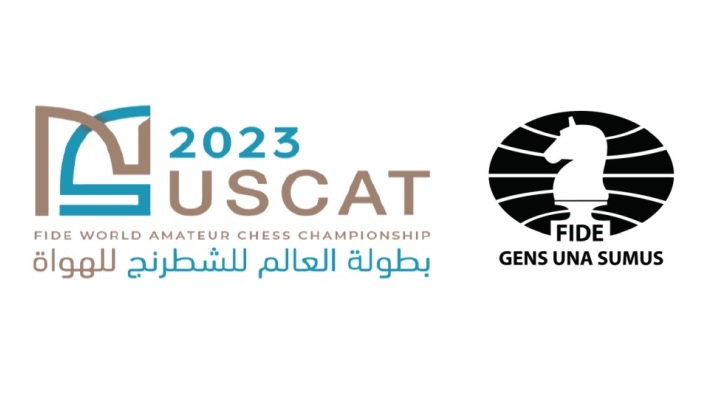
World Amateur Chess Championship 2023 is about to kick off in the Sultanate of Oman. The World Amateur Chess Championship 2023 is set to commence on Thursday, November 2. Hosted by the Sultanate of Oman, represented by the Oman Chess Committee (OCC), the competition will be held in the Sultan Qaboos Sports Complex in Bausher from November 1 to 11. The championship attracted 427 players from 64 countries, including 356 male players and 71 female players. The first round of the championship will begin on November 2 under the auspices of Said bin Sultan al Busaidi, Undersecretary for Culture at the Ministry of Culture, Sports and Youth. The OCC revealed its readiness from all organizational, technical, and administrative standpoints to host the World Amateur Chess Championship 2023. This announcement was made during a press conference held at the Sultan Qaboos Sports Complex, attended by OCC Chairman Ahmed bin Darwish al Balushi and various media outlets. Ahmed al Balushi stressed the committee’s commitment to creating an unforgettable experience for participants and spectators alike. He emphasized that partners and CEOs of sponsoring companies will sponsor the initial rounds of the championship. The presidents of Arab, Asian, and International Chess federations will arrive in Muscat during the tournament, Al Balushi said. The OCC chief disclosed that an array of special activities and tours had been meticulously designed to help participants explore the attractions of the Sultanate. These initiatives include an international coaching course conducted throughout the championship. Furthermore, there will be daily activities tailored for schools and children in the morning to attract approximately 100 children daily and promote their interest in chess. The championship will receive comprehensive coverage, both from local media and through live broadcasts on several official channels, including the International Chess Federation channel. To enhance the coverage of the championship and audience involvement, a dedicated YouTube channel has been launched. This channel will feature commentating in Arabic and English, as well as technical experts and trainers from various teams to analyze the games daily and highlight the action on top boards. Elaborating on the championship’s format, Al Balushi said it would be a 9-round Swiss tournament with classical time control (90 minutes + 30-second increment). Alongside the main event, the OCC will host the School Chess Festival on November 2 in cooperation with the Oman School Sports Association. This festival targets more than 1,000 male and female students from first-grade classes representing nine educational directorates in various governorates, including Al Dakhiliyah, Al Dhahirah, Al Buraimi, Dhofar, South Al Sharqiyah, North Al Sharqiyah, Muscat, and North Al Batinah. The festival will be held at the directorate level, aiming to enhance national loyalty while encouraging chess practice for improving developmental and cognitive skills in students, stimulating creative and innovative thinking and promoting a different and distinctive way of thinking. The festival in the governorates will include various accompanying events, including face painting, children’s favourite performances, visual displays, plays, student shows and diverse competitions, all with the aim of introducing chess in a unique way. THREE CATEGORIES The competitions in the World Amateur Chess Championship will be held in three sections. In the ‘1700’ rating category, 270 players, including 210 male players, are participating. In the ‘2000’ rating category, 74 players, including 96 male players, are taking part. In the ‘2300’ rating category, 74 players, including 69 male players, will compete. The extensive participation highlights Oman’s reputation in hosting tournaments, and it reflects the vast interest and importance of the championship. As for the participating countries, according to Al Balushi, 64 are taking part, including Algeria, Argentina, Azerbaijan, Brazil, Bahrain, Belgium, China, Chile, Croatia, Cyprus, Czech Republic, Egypt, England, Spain, Finland, France, Germany, Hungary, Indonesia, India, Iran, Iraq, Italy, Jamaica, Jordan, Japan, Kazakhstan, Saudi Arabia, Kuwait, Libya, Lebanon, Lithuania, Morocco, Malaysia, Maldives, Mexico, Paraguay, Peru, Philippines, Palestine, Mongolia, Pakistan, Poland, Qatar, Romania, Singapore, Sri Lanka, Sudan, Slovakia, Sweden, Syria, Taiwan, Turkey, the United Arab Emirates, Uganda, Ukraine, the United States, Uzbekistan, Yemen, Zimbabwe, Kenya, Kyrgyzstan, and the Sultanate of Oman. Through hosting this championship, the OCC aims to enhance the chess community in the country by attracting more players and arbiters and encouraging new clubs to join. They also aim to raise the international ranking of some of their players, contributing to the development and growth of chess in Oman. The Oman Chess Committee is making every effort to provide a unique experience for participants and the audience and to strengthen its position as a leading global sports destination in the world of chess. Hosting the championship in Oman is a culmination of the efforts made by OCC. It reflects the confidence of the International Chess Federation in the capabilities of the OCC to organize and succeed in this global championship. The competition is officiated by 19 international arbiters, headed by the Malaysian Abdul Hamid bin Abdul Majeed. The Omani international, Muslim al Wadhahi, was also appointed as the deputy chairman of the Arbiters Committee. The committee includes the Iranian Mehrdad as the coordination officer, in addition to members Babrzhan from Kazakhstan, Ahmed Ajmi from Egypt, Asaad Tawfiq from Iraq, Abdullah Murad from the United Arab Emirates, Khalf al Azmi from Kuwait, as well as Khaled al Hadidi, Hamdan al Hinai, Roqaya al Balushi, Sultan al Harasi, Ahmed al Kharousi, Khadija al Qasimi, Yasser al Raisi, Younes al Rashidi, Fatima al Gharibi, and Aliaa al Siyabi from Oman.
FIDE approves new regulations for Affiliated Members
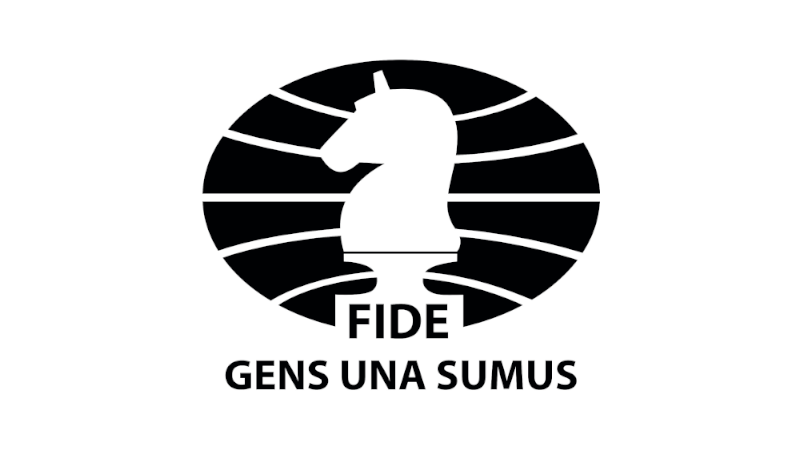
FIDE has introduced new regulations for Affiliated Members, paving the way for territories and regions to join the International Chess Federation The International Chess Federation (FIDE) has updated the regulations for Affiliated Members following approval from the FIDE Council. They will come into effect on November 1. The new regulations enable organizations that encompass Member Federations, associations representing regions or transnational territories, and groups dedicated to specific chess activities to become Affiliated Members. To be granted this status, organizations will need to secure consent from the FIDE Member Federation in their respective state, offer a rationale based on geographical or historical foundations outlining their specificities, and demonstrate operational autonomy while adhering to the standards of the chess community. Affiliated Organizations (or Affiliated Members) will have the right to take part in FIDE Congress and the General Assembly but will not have voting rights. They can organize and engage in FIDE competitions based on the specific rules and regulations of these events. This includes sending representatives to international team and individual tournaments, such as the Chess Olympiad and World Championships. They are also eligible to take part in development programs and other FIDE projects in accordance with the specific regulations for these initiatives. This development received a warm reception from the Isle of Man, currently hosting the Grand Swiss tournament, which applied to be a member federation of FIDE over 20 years ago, but the application was declined. “After the election of Mr Dvorkovich as FIDE president, we again made enquiries about the possibility of us becoming a FIDE federation, but it was not possible due to the Isle of Man not being a member of the United Nations or the International Olympic Committee. Instead, we were invited to apply to become an affiliated organization of FIDE, and this status was granted to us in late 2020”, explains Alan Ormsby, the well-known chess organizer from the Isle of Man and the director of the Grand Swiss. “Affiliated status led to the Isle of Man being recognized as a country in the FIDE ratings database, compared to the previous situation whereby our members had to be shown under the flag of England. Furthermore, the Isle of Man now has an International Ratings Officer, allowing us to register FIDE-rated tournaments. The biggest benefit of affiliated status, however, is that the Isle of Man can now enter a team in the FIDE Olympiad, which we’ll be doing for the first time at the 2024 Olympiad in Budapest. Isle of Man Chess Association is grateful to Mr Dvorkovich and his team for making this happen,” Ormsby said. FIDE President Arkady Dvorkovich welcomed the decision by the Council. “This change will help expand FIDE’s global outreach, fostering increased opportunities for chess development and the engagement of players from different regions and backgrounds. It’s a significant step toward democratizing chess and broadening access for diverse groups of people.” The new regulations can be found here.
Storms on and off the board in Round 6 of FIDE Grand Swiss
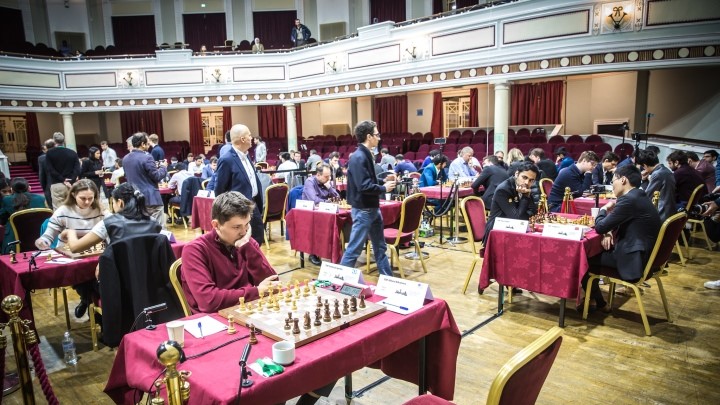
Strong winds and big waves battered Douglas all day. Before the rest day, the atmosphere was tense – nobody wanted to lose. It resulted in several draws, but some players could not stand the tension. Evgeny Najer blundered in an equal position to lose to Fabiano Caruana, while Javokhir Sindarov destroyed Samuel Sevian’s queenside, where the opponent’s king was hiding. A dramatic win by Anna Muzychuk in a drawn queen endgame against Bibisara Assaubayeva allowed her to take over the sole lead, as her main rivals could only manage draws. There was a big surprise in the opening on board one. Andrey Esipenko had a won position against Hikaru Nakamura at the FIDE Grand Prix in Berlin in 2022 when Nakamura played his usual Giuoco Piano, though that game ended in a draw. Nakamura has met Esipenko’s 1.e4 with 1…e5 in all the games they’ve played so far, but in the sixth round of the FIDE Grand Swiss, he surprised his opponent with 1.e4 c5 2.Nf3 g6. Nakamura tested the Accelerated Dragon in Qatar Masters to draw with Javokhir Sindarov, but he played it via the 2…Nc6 3.Nc3 g6 move-order. By playing 2…g6 he wanted to avoid the Rossolimo with 3.Bb5, but it allows the Maroczy Bind after c4. These considerations set Esipenko thinking as early as move three! He went for 3.c3 d5, and then instead of a transposition to the Alapin by taking on d5, he closed the centre with 4.e5. Nakamura developed the knight to c6, and after …Bg7 undermined White’s centre with …f6. This plan has been played by Assaubayeva, Vakhidov, Abdusattorov, Sindarov and Svane, so Nakamura had ample material to work with. Both players developed, and at the beginning of the middlegame White sacrificed a pawn to open the central files. The pawn on g5 is taboo as taking it allows …e7-e5 with tremendous initiative for Black. White played 14.Ne5! Nxe5 15.dxe5 Bxe5 16.Nc3 attacking the pawn on d5 and forcing 16…e6. Esipenko’s compensation consisted of his harmonious development (Black still needs to develop the light-squared bishop), pressure along the central files (especially on the e-file against the backward pawn on e6) and a safer king. The game ended in a perpetual check at the moment of highest tension. White is on the verge of clamping down the centre with Bxg6 and Be5, but Black is just in time with 20…e5. Everything is forced now as White must take on g6 and after 21.Bxg6 exd4 22.Qh5 hxg6 23.Qxg6 White delivers a perpetual check. On board two, Yu Yangyi faced the uncomfortable psychological task of coping with his own favourite opening, the Petroff Defence. Arjun Erigaisi seemed to catch his opponent unprepared. In spite of following a theoretical line, White was spending a lot of time on the known moves. As usual in such cases, Black demonstrated his perfect opening preparation and effortlessly made a draw by exchanging almost all the pieces by move 22. After the queens, the queenside pawns were also exchanged, and the draw was agreed on move 30. On board three, Fabiano Caruana used the same line in the Giuoco Piano Alireza Firouzja played against him at the Paris GCT in 2021 with 5.Bg5. It would be nice to know whether he was inspired by yesterday’s report and Morphy’s game. His opponent Evgeny Najer seemed surprised, especially as Caruana refined the opening idea by pushing his a-pawn to a5 and then opening the a-file with axb6 when Black played …b6. The beginning of the middlegame promised a complex game ahead for both players. The position remained equal, and pieces started to come off. But then, Najer blundered. Here 25…Qd8 or 25…Re7 would have kept the balance. Najer went for 25…Qa5? allowing 26.Qf3! Re7 27.Nxg6! with a winning position. In spite of spending eight minutes, Caruana missed this tactic and played 26.Re4, allowing Black to escape out of trouble by 26…f5 or 26…Be6. Najer blundered for a second time with 26…Nf6? And this time, Caruana was ruthless with 27.Nxd7! Nxe4 28.dxe4 Rxe4 29.Qf3, winning two pieces for a rook. White attacks the pawn on f7, so Black was further forced to go into a lost endgame with 29…Qf5 30.Qxf5 gxf5 31.Nb8 with the knight coming to c6. Caruana converted the advantage and won in 37 moves without allowing any more chances. On board four, Vladislav Artemiev chose an innocuous line against Alireza Firouzja’s Arkhangelsk Variation. In addition to that, he also spent masses of time on theoretical moves. His choice quickly led to an endgame where Black had little to complain about. Artemiev managed to keep the pair of bishops. Given his excellent endgame technique, it must have given him some hope. The main problem for both players was the time management – by move 15, they had spent more than an hour, leaving them with a bit more than 30 minutes to reach the time control on move 40. Black’s free-piece play and space advantage do not allow the white bishops to show their might. The critical moment arose on move 16. Black could have played the natural 16…Bf5, but he went for the pawn sacrifice with 16…Bg4 instead. After 17.Bxe5 Bxe2 18.Bxc7 Bd3 he hoped that the opposite-coloured bishops, his strong bishop on d3 and the possibility to advance his kingside pawns would provide enough compensation, but Artemiev played extremely well to neutralize these factors and obtain a winning position. However, in severe mutual time trouble, Artemiev made a decision that is hard to explain. Instead of the natural 36.Re7, Artemiev abandoned the jewel of his position, the passed c6-pawn on c6 35.Nc4? to go for the pawn on g5 after 36…Rxc6 37.Re5 Kf6 38.Be7 Kf7 39.Bxg5, but it was an unequal exchange. Black activated his rook with 39…Re6-e2 and obtained enough play for a draw. White tried to make something of his extra pawn, but the best chance for that was long gone. Javokhir Sindarov won a fierce attacking game with the black pieces against Samuel Sevian. In a King’s Indian structure, White castled queenside but was hit with a series of blows, similar to the strong waves that crashed against the shore in Douglas. The first one came early. Black executed the typical central strike with 9…d5, obtaining free piece play.
165 years of chess history in Round 5 of FIDE Grand Swiss
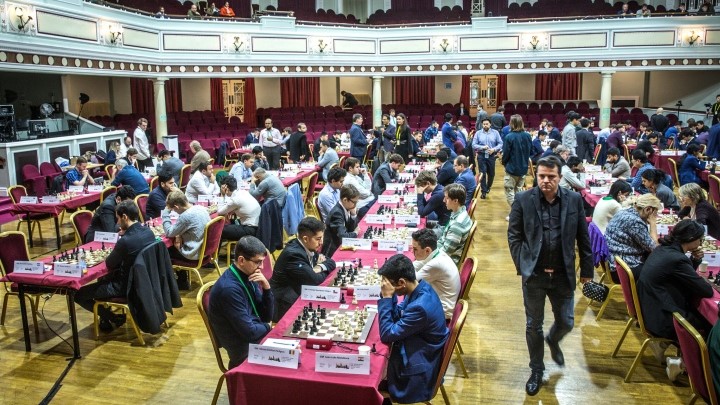
The draws on the top boards allowed Hikaru Nakamura to join the leaders as the only player to win in the upper echelon. The game of the round was undoubtedly the insanely complex battle between Alireza Firouzja and Hans Niemann. Black had excellent winning chances, but in mutual time trouble, he missed them. In the derby of the women’s section, Bibisara Assaubayeva turned things around after falling into a strategically lost position after the opening. This victory made her the sole leader in the Women’s Grand Swiss. In the fifth round of the FIDE Grand Swiss, the leader of the tournament faced the top seed on board one. Andrey Esipenko was surprised in the opening by Fabiano Caruana’s move-order after 1.d4 Nf6 2.c4 e6 3.Nf3 a6!? The point of this a-pawn move is to avoid the Catalan. In case White continues with 4.g3, then Black has the option of 4…b5!?, a move that was recently played by Hikaru Nakamura. Esipenko continued along the usual lines with 4.Nc3, and after 4…d5, we had a transposition to the line Caruana played in Round 3 against L’Ami. Perhaps to avoid possible surprises, Esipenko sprung his own surprise a few moves later. In the tabiya of the line with early …a6 he played a mysterious king move. In this position, White usually chooses among 10.Bf4, 10.Qc2 and 10.h3, but Esipenko came up with a somewhat abstract move 10.Kh1!? with some ideas of pushing the g-pawn or/and safeguarding against accidental checks on h2 or along the g1-a7 diagonal if White opens it by pushing f3 and e4 or f4. Still, the main advantage of the move was to sidestep the mainstream theory. On his next move, White tried to expand on the kingside with Nd2 and f4, which Caruana prevented by pushing …h6 and …g5. In a complex middlegame, both opponents played well, and after a series of exchanges, the draw was agreed by perpetual check on move 42. On board two, Hikaru Nakamura was luckier than Esipenko – his opponent Alexey Sarana didn’t prevent him from playing the Catalan. As is his habit early in the game (which makes him one of the trickiest players when it comes to opening preparation), Nakamura introduced an early “twist” by playing the sideline 8.Bc3 (compared to the more popular 8.Qc2, 8.Qb3, 8.a4, 8.Bf4). Black continued with 8…b6, and after 9.cxd5, he took on d5 with the pawn, unlike Magnus Carlsen, who, in his blitz game against Ding Liren in 2017, captured with a knight, keeping the long diagonal open. Soon enough, the position took Queen’s Indian shape where Black creates some activity in the centre with …c5, but his bishop on b7 is rather passive. In the complex middlegame, the position with Black’s hanging pawns on c5 and d5 arose. White tried to put pressure on them while Black had free-piece play thanks to the space those pawns provided. In this critical position, Black pushed the wrong pawn. Correct was 18…c4! 19.Nd4 Rfd8, when the nice blockading knight prevents White from attacking the pawn on d5. Sarana went for 18…d4?! and after 19.Bxb7 Qxb7 20.Rc4 White got a chance to concentrate his pieces against the c5-pawn. Another positional mistake by Black was to offer the exchange of bishops, which removed the best defender of the c5-pawn. After that, the pawn on c5 was doomed, and White won it. However, Nakamura wasn’t perfect in the conversion phase. White should have transferred the knight via e1 to f3, but instead, he went for 29.Nc5? allowing 29…Qh3 (or 29…Qg4 or even 29…Rxc5! 30.Rxc5 hxg3 31.hxg3 Nf4! with equality) and suddenly Black had sufficient compensation. However, Alexey missed several good chances and lost the d4-pawn. Sarana regained one pawn by taking on b2, but after the exchange of queens, he lost the far-advanced pawn on h3. Nakamura converted the two-pawn advantage in a long knight endgame with patient play. On board three Alireza Firouzja played the King’s Indian Attack against Hans Niemann, but just like Nakamura, he introduced a little twist early on. In this standard position, White usually plays 6.Nbd2, with the intention to push e4, but Firouzja opted for 6.Re1!?. The move also prepares e4, but not immediately, as White first wants to develop with Bf4 or Nc3, for example. Niemann responded with 6…Nc6, intending …e5, to which Firouzja changed the structure by preventing it with 7.d4. The opponent stepped into uncharted territory soon enough as after 7…a5 8.Nc3 Ne4 9.Nb5, the position was already very original and new. The game left the safe territory when, on move 16, Niemann sacrificed two pieces for a rook and a pawn. He played 16…Nxf2!? 17.Rxf2 Bxf2 18.Kxf2 Qxf6 19.Kg1 Qxb2 when the game became a big mess. Objectively, the position was balanced, but it was easier to play with Black since he had the safer king and White’s pieces lacked coordination. Both players entered severe time trouble, and this affected the quality of their moves. There were some difficult decisions to be made with very little time on the clock. It looks very dangerous for White, but in fact, he can stay afloat with 26.Ba6 or 26.Nd2. Firouzja went for 26.Qd2? which should have lost after 26…Qxc4 27.Qxd7 and now 27…Rfe8! was the killer blow. Niemann missed it and went for 27…Re2? after which the position was equal again. The engine indicates the move 28.Rc1! when the complications continue. He didn’t find this move, and after the natural 28.Bxc6 a forcing variation after 28…Qc5 29.Kh1 Qf2 30.Qh3 Re1 31.Rxe1 Qxe1 and the subsequent exchange of queens (which was premature, as Black should have kept the tension by playing …a3) on f1 led to Black winning the pinned bishop with …g5. White won the pawn on a4, and then after the time control, the following endgame appeared. This position is objectively a draw, and Firouzja managed to prove it. A wild game! On board four, Javokhir Sindarov and Yu Yangyi tested a long theoretical line in the Petroff. They followed a game by Sindarov played only a month prior to this tournament, a game he won against Bu Xiangzhi. Yu Yangyi deviated from the play of his compatriot by introducing a novelty on move 16 and quickly equalized. In the Evans
List of arbiters for green, blue, red, and yellow panels in FIDE Events 2024-2025 published
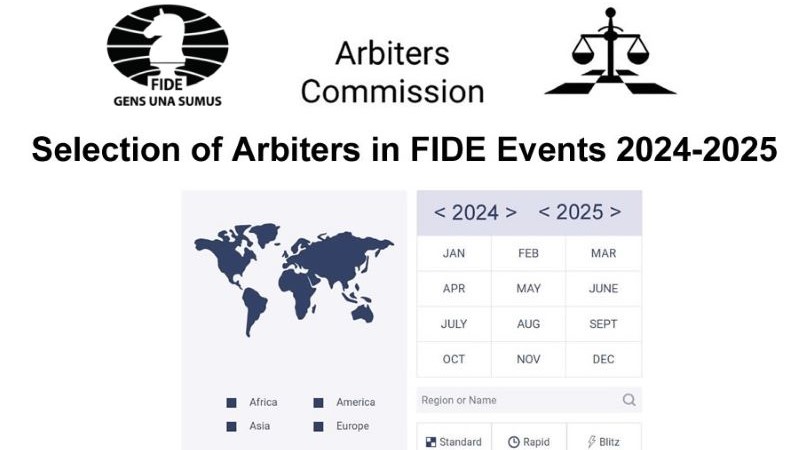
Dear Chess Friends, Chess Arbiters, The FIDE Arbiters’ Commission is pleased to release the List of arbiters for the green, blue, red, and yellow panels, which will be used for making appointments to FIDE events during the 2024-2025 cycle. We would like to thank the hundreds of Arbiters from around the world who responded to the Call of Interest for Arbiters in World Events 2024-2025 (almost 600 colleagues from 116 Federations). The panel system is described in the FIDE Handbook, B06.4 – FIDE Regulations for the Appointment of Arbiters in World Events, including Appendix B06.4.B – Arbiter Selection Procedural Rules. There are four panels named by colour: A Green Panel , containing 25 International Arbiters of category A A Blue Panel, containing 45 International Arbiters of category A or B A Red Panel, containing 60 International Arbiters of category A or B A Yellow Panel, containing the remaining International Arbiters or FIDE Arbiters of any category The Arbiters’ Commission started the procedure by releasing a Call of Interest for all International Arbiters and FIDE Arbiters who hold a valid FIDE arbiters’ license. The Call of Interest was open for more than a month, from July 25th to August 24th, 2023, and was then extended until August 28th, 2023. In total, 143 Arbiters with IA-A and IA-B categories responded to the Call for Interest. During the meeting on September 2nd 2023, the voting members (FIDE Arbiters Commission councilors, ARB Chairman, ARB Secretary), discussed the criteria for selecting arbiters for panels. The meeting was also attended by the Team of Consultants (FIDE Council, FIDE Management Board, Global Strategy Commission, and Events Commission representatives). The following criteria were used to select arbiters: gender (the total number of arbiters must be at least 25% female and at least 25% male), experience and level of arbiters’ category, undergone preparation for the appropriate arbiter position, software skills, language (English), leadership skills, teamwork skills, activity as an arbiter in the last few years, previous behaviour or misbehaviour during chess events. These selection criteria were applied by a team of voting members who used consensus as a decision-making method. The panels were formed following the FIDE Regulations, particularly B.06.4 FIDE Regulations for the Appointment of Arbiters in World Events (effective July 20th, 2023) and selection criteria. Each voting member received a list of 143 arbiters (arbiters Category A and B who participated in the Call of Interest for World Events 2024-2025) and voted for every other arbiter on it (on a scale of 143 points to 1 point). For the initial draft, the lowest score was dismissed as none of the voting members could vote for themself. Voting members discussed the draft with the Team of Consultants so as to be able to present you the final version of the List of arbiters for the green, blue, red, and yellow panels. The Arbiters’ Commission believes that this list was made in the best interests of FIDE and arbiters worldwide. Moreover, we expect that its content and integrity will be proved over the following two years when these arbiters complete their duties at FIDE World Events. Ivan Syrovy, ARB Chairman Nebojsa Baralic, ARB Secretary According to the FIDE Regulations for the Appointment of Arbiters in World Events (B.06.4), arbiters selected for the Green Panel are eligible to be appointed as: 1) Chief Arbiter of category A tournaments 2) Any role that members of the Blue Panel, Red Panel or Yellow Panel may be appointed to The Green Panel will be composed of 25 arbiters, all of whom must be Category A. The Green Panel will be used to appoint: 1) The Chief Arbiters of all Category A tournaments 2) The equivalent number of positions as Chief Arbiters in Category B tournaments LIST OF ARBITERS / GREEN PANEL (alphabetical order): Name Federation Title Category Continent Abd Hamid Bin Abd Majid MAS IA A Asia Abdulrahim, Mahdi UAE IA A Asia Bansod Swapnil IND IA A Asia Baralic, Nebojsa SRB IA A Europe Bertagnolli, Gerhard ITA IA A Europe Brokko, Margit EST IA A Europe de San Vicente, Sabrina URU IA A America Delega, Tomasz POL IA A Europe Escafre, Stephane FRA IA A Europe Freyd, Laurent FRA IA A Europe Gopakumar M S IND IA A Asia Holowczak, Alex R ENG IA A Europe Japaridze, Marika GEO IA A Europe Mena Sarasola, Jesus ESP IA A Europe Munoz Solis, Carolina CRC IA A America Nikolopoulos, Panagiotis GRE IA A Europe Pahlevanzadeh, Mehrdad IRI IA A Asia Sorokina, Anastasia AUS IA A Asia Srebrnic, Ana SLO IA A Europe Syrovy, Ivan SVK IA A Europe van den Bergh, Gunther RSA IA A Africa Vardapetyan, Ashot ARM IA A Europe Wolter, Jens GER IA A Europe Zhu, Jiaqi CHN IA A Asia Note: one spot is not occupied and during the cycle one arbiter can be added to green panel According to the FIDE Regulations for the Appointment of Arbiters in World Events (B.06.4), arbiters selected for the Blue Panel are eligible to be appointed as:1) Deputy Chief Arbiter of category A tournaments2) Chief Arbiter of category B tournaments3) Any role that members of the Red Panel or Yellow Panel may be appointed to The Blue Panel will be composed of 45 arbiters, all of whom must be Category A or B. The Blue Panel will be used to appoint:1) The Chief Arbiters of all Category B tournaments not assigned to the Green Panel2) The Deputy Chief Arbitersa) in all Category A tournamentsb) of twice the equivalent number of positions from a) in Category B tournaments LIST OF ARBITERS / BLUE PANEL (alphabetical order): Name Federation Title Category Continent Alhammadi, Faisal UAE IA B Asia Andrikopoulou, Efstathia GRE IA B Europe Bailleul, Geert BEL IA A Europe Bayat, Shohreh ENG IA A Europe Biagioli, Marco ITA IA A Europe Bird, Christopher USA IA B America Boyd, Stephen FRA IA B Europe Brustman, Agnieszka POL IA B Europe Caliskan, Ismail TUR IA B Europe Cimina, Andra LAT IA A Europe Dapiran, Franca
Four slow Slavs in Round 4 of FIDE Grand Swiss
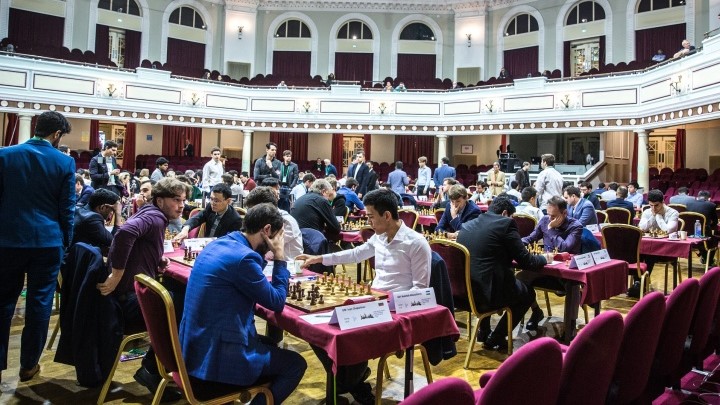
Former prodigy Andrey Esipenko overcame the reigning World Junior Champion Marc’andria Maurizzi for a third win in four games and emerged as the sole leader in the open section. There was excitement everywhere, from Erigaisi’s king walk to b4 to the theoretical duels in the Slav and Volokitin’s touch-move rule violation. In the women’s section, Anna Muzychuk missed a huge chance to win a fourth game after spoiling her excellent opening preparation e against former World Champion Tan Zhongyi. Bibisara Assaubayeva and Rameshbabu joined the leaders with convincing wins The Slav Defence is one of the most popular openings. Its popularity comes from its versatility, as it allows Black to choose from several set-ups according to their tastes. However, White also has a say when it comes to the Slav. The Exchange Variation, for example, is not as dull as it may sound, but there is also the so-called slow Slav, where White intentionally slows the thigns down, thus avoiding the sharp options like the Semi-Slav, the Botvinnik Variation or the Anti-Moscow gambit. In round four of the FIDE Grand Swiss, there was an unexpected occurrence of the slow Slav on the top boards. On board eight, Radoslaw Wojtaszek chose the slow Slav against Anish Giri. Then, curious things started to happen early on. In the position after 1.d4 d5 2.c4 c6 3.Nf3 Nf6 4.e3, Black has three main moves, and these are 4…Bg4, 4…Bf5 and 4…e6. Giri chose the first one. Interestingly, Wojtaszek was on Team Anand in 2008 when Anand played the World Championship match against Kramnik. The Slav Defence was Anand’s main weapon in that match, which he won thanks to excellent preparation in the sharpest lines of the Meran. While preparing the Slav in general, the team considered the slow Slav as well, and their intention was to play the line with 4…Bg4! Fast-forward to 2023, and here we see Wojtaszek on the white side of the line he prepared as Black in 2008! He continued with 5.Qb3 Qb6 6.Ne5 and they followed mainstream theory for a while. Suddenly, White got a great chance. Black’s last move 15…h5? was positionally sound – stopping possible White expansion on the kingside, but it turned out to be too inconcrete. Possibly, Giri was lulled by the “slowness” of the Slav and didn’t expect any dynamic factors. Luckily for him, so did his opponent as he continued with the “slow” 16.Rhd1? missing a great chance to put his opponent under tremendous pressure with 16.Na5! Rb8 17.e4 Nc7 18.Bf4 Kd7 19.Nc4 and Black is on the brink of defeat as White threatens Rxa7 and Ne5. With this unexpected chance not taken, White couldn’t pose more problems, and the subsequent advance in the centre with e4 and d5 only led to simplifications and a draw. On the next board, board nine, Hans Niemann chose the slow Slav against Richard Rapport. Black deviated quickly from the board he could easily see next to him and chose 4…Bf5. After 5.Nc3 e6 6.Nh4 Bg6 7.Qb3 Qc7, both players followed theory, and when it ended, a complex middlegame was on the board. This is a rather typical situation in the slow Slav, where White’s pair of bishops is compensated by Black’s solid position and better pawn structure. It was a true slow Slav until the final moves before the time-control. Instead of continuing to manoeuvre with 39…Rc8 or 38…Bb8, Rapport took the poisoned pawn on a5 and was swiftly punished after 39…Bxa5? 40.Qa4 Qc7 41.b4 Bb6 42.Bxa6! White transferred the rook to a2 and launched a decisive attack along the a-file. Two more slow Slavs were played on boards 14 and 15. On board 14, Santosh Gujrathi Vidit decided to try to tame Alexey Shirov by slowing things down. Shirov played his usual choice against this line, 4….Bf5 5.Nc3 e6 6.Nh4 Be4 (deviating from Rapport’s 6…Bg6) 7.f3 Bg6. The idea of the move …Be4 is to provoke a slight weakening in White’s position with the move f3. The game followed an earlier game by Vidit, played against Illya Nyzhnyk, and it was surprising to see Shirov not try to improve on that game and end up in the same inferior position as Nyzhnyk. Black should have played …Nb6 before taking …c5xd4, and now both Shirov and Nyzhnyk found themselves in an inferior position. Black’s main problem is the lack of safe shelter for the king – if it stays in the centre, then f4-f5 is coming, and if it goes to the kingside, then h4-h5 is dangerous. Shirov’s time management, spending almost an hour to reach a position that his opponent had played earlier, perhaps indicated that his preparation wasn’t of the highest quality. Shirov eventually deviated from the game Vidit-Nyzhnyk on move 22, but he was already in a very bad position. Vidit won without too many problems. On board 15 Nikita Vitiugov and Chithambaram Aravindh followed the game Niemann-Rapport for a few moves before deviating with 7.Nxg6 hxg6 8.Bd2 Nbd7. In this popular position, White chose the relatively rare 9.cxd5, transposing to a Carlsbad structure. His intentions were aggressive, as after 9…exd5 10.Qc2, he prepared long castling. Black wasn’t very precise, and White quickly built up an attack with f3 and g4. However, Vitiugov misplayed and rushed with g5, allowing Black to block the kingside with …Nh5, then it was Black who started to attack at the queenside! He achieved a winning position, but then… Instead of 32…Qf1 or 32…Qd1 or even the prophylactic 32…Kh7, Black rushed with 32…Re1? when after 33.Qb8 Kh7 34.Qg3! suddenly, it was White who was better! The threat of mate with Rc8 forced Black to go back with the rook when Black’s attack was gone, and White could go on to collect the c4-pawn and advance his central pawns. Vitiugov exchanged rooks and entered a queen endgame, but now it was his turn to be imprecise. White already gave checks on c8 and h3, but here he missed that after the immediate 44.Kxa6? Black has the excellent 44…f5! cutting off the white queen and advancing his own passed pawn. After this, the position is objectively a draw, and Black managed to reach it. The winning manoeuvre was 44.Qc8 Kh7 45.Qc6!
José Cubas and Thalia Landeiro win 2023 Pan American Chess Esports Finals
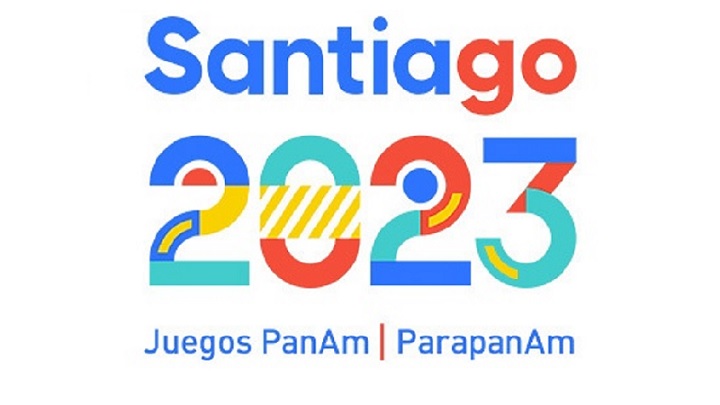
Chess was a part of the 2023 Pan American Games in Santiago in the Esports category, with the open and women’s finals taking place online on chess.com from October 26-27. Both competitions were eight-player round robins with 3+2 time control. The opening ceremony was attended by the Vice President of FIDE, Mario Ramirez Barajas, who stressed the importance of chess in the Pan American Games; the President of FIDE America, Jose Carrillo Pujol, who summarized the scope of the event and inclusion of chess in multisport events and a member of the FIDE Chess in MULTISPORT Games commission, Mario Petrucci, who had a meeting Thomas Bach, President of the International Olympic Committee, where he discussed a possible chess inclusion in the Olympic Games. The open final saw the triumph of GM José Cubas (Paraguay). Despite losing to Diego Flores of Argentina in Round 2, Jose scored an impressive 5.5/7 and finished first a full point ahead of Andrés Rodríguez Vila (Uruguay). Santiago Yago Moura (Brazil) tied for third place with Diego Flores and took bronze thanks to a slightly better Sonnenborn-Berger. Final standings: 1 GM Cubas, Jose Fernando PAR 2542 5½ 2 GM Rodriguez Vila, Andres URU 2387 4½ 3 GM Santiago, Yago De Moura BRA 2453 4 4 GM Flores, Diego ARG 2603 4 5 GM Hernandez , Gilberto MEX 2521 3½ 6 WGM Francisco, Candela ARG 2320 2½ 7 GM Hungaski, Robert USA 2433 2 8 GM Zambrana, Osvaldo BOL 2373 2 The women’s tournament was a very close race, with Thalia Landeiro Cervantes and Miranda Yerisbel sharing first place on 5.5/7. Thalia came out on top thanks to a greater number of victories, whereas the runner-up, Yerisbel, became the only undefeated participant. Deysi Cori netted 5/7 and finished third. Final standings: 1 WGM Landeiro Cervantes, Thalia USA 2303 5½ 2 WGM Yerisbel, Miranda CUB 2262 5½ 3 IM Cori, Deysi PER 2367 5 4 WIM Corrales Jiménez, Zenia MEX 2140 4½ 5 WGM Pérez Rodríguez, Jennifer PAR 2242 3 6 WIM Argote Heredia, Valentina COL 2179 2 7 WIM Campos, María José ARG 2206 2 8 Ruchinskaya, Valerie CAN 1862 ½ Games and results
FIDE Grand Swiss: King’s Representative sparks excitement in Round 3
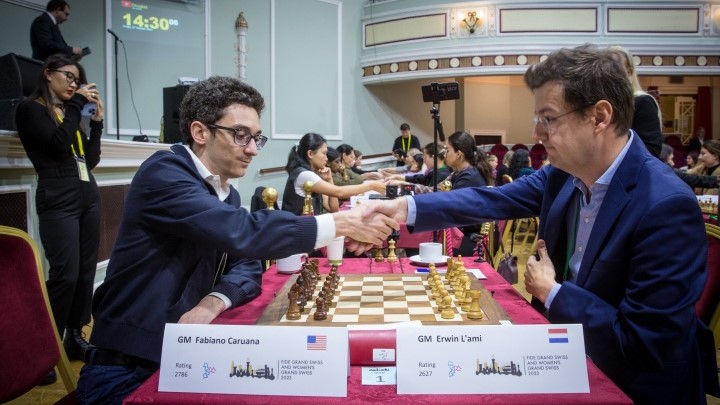
There were multiple draws on the top boards in the open section and many wins in the women’s section today. Only Tan Zhongyi and Anna Muzychuk have maintained their 100% score, with a massive tie for first place in the open section. Some players took risks; others didn’t, producing a mix of exciting and theoretical games in Round 3 The third round of the FIDE Grand Swiss was visited by His Excellency Sir John Lorimer, Lieutenant Governor and the King’s representative on the Isle of Man. He walked around the tables for a venue tour and had pleasant conversations with the tournament director Alan Ormsby, the FIDE Delegate Jeroen van den Berg and FIDE’s CEO Emil Sutovsky. The esteemed guest also paid a visit to the broadcast room, enjoying the live commentary of the games in progress. The visit happened after the start of the round, and while the players may have been aware of the visit, their opening choices didn’t seem affected by the occasion. On board one, Erwin L’Ami was somewhat surprised (meaning before the game he didn’t revise his notes on that particular variation – make no mistake, these players have analyzed everything, so it is only a matter of memorizing those notes) by Fabiano Caruana’s choice of the …a6 line in the Queen’s Gambit Declined, arising after 1.d4 d5 2.c4 e6 3.Nf3 Nf6 4.Nc3 a6. L’Ami went for the Carlsbad structure by taking on d5, and Caruana sprung another minor surprise by developing the knight on the c6-square. Instead of the more common 8…0-0 followed later by Nd7, Caruana played the rare 8…Nc6!?, a move played by his compatriot and a participant of the tournament, Jeffery Xiong. The Carlsbad structure was soon transformed. After Black jumped on e4, a couple of light pieces were traded, and the following position appeared on the board. Soon, the queens and the light pieces were exchanged, leading to an equal double-rook endgame and a draw. On board two, Arjun Erigaisi’s 1.e4 was met by Alexey Sarana’s Petroff. Sarana is a well-known Najdorf player, but here he opted for solidity. White went for the aggressive 5.Nc3, and soon the opponents castled to the opposite sides. In a well-known position, Sarana deviated from the main moves 10…c5 and 10…Re8 in favour of the third suggestion by the engine: Sarana opted for 10…d5, a move played several times by Wei Yi in 2019. The game soon left theory, and in the middlegame, Black sacrificed a pawn in order to establish a blockade on the dark squares. Black’s compensation is obvious as White cannot establish any control over the dark squares. After a lot of manoeuvring, White managed to first get into a double-rook endgame and then into a rook endgame and certainly improved his chances. However, as everybody knows, all rook endgames are drawn. On board three, a quick draw was agreed in the game between Andrey Esipenko and Alexandr Predke. This was a result of Black’s excellent opening preparation. In a long theoretical line of the Rossolimo that the engines evaluate as clearly better for White, Predke dug deeper and realized that Black, in fact, has a fortress-like position. White’s only active plan is to try to push f4, but Black is ready to deal with this. Therefore, Esipenko found nothing better than repeating moves with 22.Bg5 Be7 23.Be3 Bf8. Rest assured that Predke also knew how to deal with White’s plan of f4. An instructive example of a modern opening preparation! The surprise leader, Ramazan Zhalmakhanov, faced the stern test of playing Alireza Firouzja with the black pieces. The rating favourite chose the Catalan and had a lasting pressure on Black’s position, which the exchanges of all the pieces but the rooks didn’t entirely diminish. The game saw a curious double-rook endgame. Objectively, this is a draw, but White continued to press. Still, Zhalmakhanov deserves full credit for not buckling under the pressure and holding a draw. Anish Giri’s strategy against Etienne Bacrot is worth noting. Bacrot is known for his propensity towards time trouble, so Giri decided to surprise him early on, first by selecting the King’s Indian Attack after 1.e4 c5 2.Nf3 e6 3.d3, and later by playing the seemingly random move 7.a4. The intention was to give his opponent something to think about from the start. The move is only seemingly random – to discover the secret of its origin, switch on the engine, and you will discover that along with the natural and theoretical 7.0-0, it is the second line! (Depending on hardware and depth, it may also be the first.) Elite players pay attention to every suggestion of the engines. This approach bore immediate fruit as after spending tons of time, Bacrot decided to change the course of the game by 7…dxe4 8.dxe4 e5, but this weakened the d5-square and gave White a long-term target to aim for. Giri increased his advantage to quite some extent, but in spite of his usual time trouble, Bacrot held firm and managed to hold a draw. Hikaru Nakamura scored his first win against Aryan Chopra, but not without squandering a solid advantage first. Here, Black missed his last chance. In spite of having a lot of time after the control on move 40 he didn’t find the saving 41…Nxf3! and went for the other pawn with 41…Qxb4? which failed to 42.Qd3! and Black was losing due to the problems with the knight and the weak pawns on the kingside. In the women’s section, in the duel on board one between Tan Zhongyi and Antoaneta Stefanova, Black obtained good play against White’s hanging pawns. In a tense middlegame, Stefanova was undone by granting White a crucial tempo. Black wasn’t even forced to let the knight on d6, but once there, it had to be eliminated immediately with 23…Rxd6! 24.cxd6 Qd7. After taking the d6-pawn, Black would have had a good compensation thanks to control over the blockading square. Instead, Stefanova waited with 23…Qa8? but after 24.Bg5! Kh8 25.Qg3 she was already in trouble as taking the knight now (it was better not to!) led to the wrecking of her kingside structure with Bxf6. White soon wrapped up with a direct attack with Qh4 and Bd3. On board
Winners crowned at World Cadets Chess Championship 2023
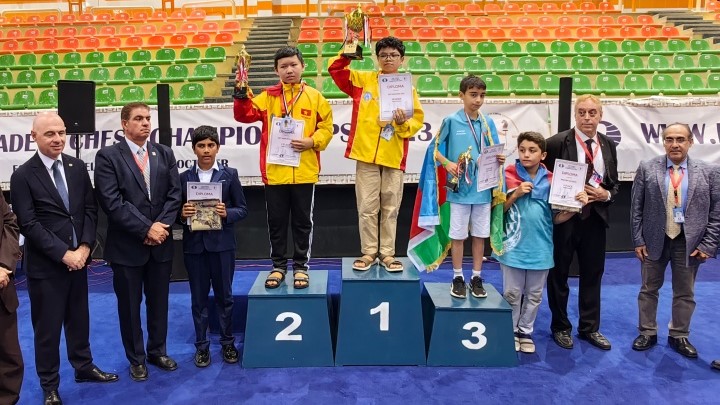
The World Cadets Chess Championship 2023 is in the books. Held in six categories (Open U-8, Girls U-8, Open U-10, Girls U-10, Open U12 and Girls U-12), the competition took place from October 16-26 in the International Youth and Sport City, Sharm El Sheikh, Egypt. The event attracted 502 young players representing 66 national federations. It was a close affair in most sections, but two of them – U8 and U8 Girls – were dominated by Roman Shogdzhiev (FIDE) and Bodhana Sivanandan (ENG), winning all eleven games. Xue Tianhao of China put in an excellent performance (10.5/11) in the U10 Girls tournament and clinched the title with a round to spare. Devindya Gunawardhana (Sri Lanka) and Diana Preobrazhenskaya (FIDE) tied for first place in the U12 Girls section, with the former claiming gold as the winner of their direct encounter. The champions and top-finishers of the World Cadets Chess Championship: U8 1. Shogdzhiev, Roman (FIDE)2. Gafurov, Aidan (FIDE)3. Andre, Tomas (SVK) U10 1. Kuandykuly, Danis (KAZ)2. Guo, Ethan (USA)3. Banerjee, Supratit (SCO) U12 1. Dau, Khuong Duy (VIE)2. Nguyen, Nam Kiet (VIE)3. Ahmad, Khagan (AZE) U8 Girls 1. Sivanandan, Bodhana (ENG)2. Yi, Ruiyu (CHN)3. Tran, Hoang Bao An (VIE) U10 Girls 1. Xue, Tianhao (CHN)2. Guzman Garcia, Mia Fernanda (MEX)3. Zavivaeva, Kristina (FID) U12 Girls 1. Gunawardhana, Devindya Oshini (SRI)2. Preobrazhenskaya, Diana (FIDE)3. Altynbek, Aiaru (KAZ) During a brief closing ceremony, FIDE Special Tasks Director Akaki Iashvili thanked all the participants and expressed his gratitude to the President of the Egyptian Chess Federation, Hesham Elgendy, General Mayor of Sharm El-Sheikh representing Governor of South Sinai Ramah Hashim, Senator Ramy Galal, Deputy Minister of Sports of Egypt Mohamed Fathi for their support of the event. Photos: Sergei Indeikin Official website: wccc2023.com/

